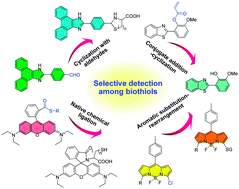当前位置:
X-MOL 学术
›
Chem. Soc. Rev.
›
论文详情
Our official English website, www.x-mol.net, welcomes your
feedback! (Note: you will need to create a separate account there.)
Design strategies of fluorescent probes for selective detection among biothiols
Chemical Society Reviews ( IF 40.4 ) Pub Date : 2015-06-01 00:00:00 , DOI: 10.1039/c5cs00152h
Li-Ya Niu 1, 2, 3, 4, 5 , Yu-Zhe Chen 6, 7, 8, 9, 10 , Hai-Rong Zheng 6, 7, 8, 9, 10 , Li-Zhu Wu 6, 7, 8, 9, 10 , Chen-Ho Tung 6, 7, 8, 9, 10 , Qing-Zheng Yang 1, 2, 3, 4, 5
Chemical Society Reviews ( IF 40.4 ) Pub Date : 2015-06-01 00:00:00 , DOI: 10.1039/c5cs00152h
Li-Ya Niu 1, 2, 3, 4, 5 , Yu-Zhe Chen 6, 7, 8, 9, 10 , Hai-Rong Zheng 6, 7, 8, 9, 10 , Li-Zhu Wu 6, 7, 8, 9, 10 , Chen-Ho Tung 6, 7, 8, 9, 10 , Qing-Zheng Yang 1, 2, 3, 4, 5
Affiliation

|
Simple thiol derivatives, such as cysteine (Cys), homocysteine (Hcy), and glutathione (GSH), play key roles in biological processes, and the fluorescent probes to detect such thiols in vivo selectively with high sensitivity and fast response times are critical for understanding their numerous functions. However, the similar structures and reactivities of these thiols pose considerable challenges to the development of such probes. This review focuses on various strategies for the design of fluorescent probes for the selective detection of biothiols. We classify the fluorescent probes for discrimination among biothiols according to reaction types between the probes and thiols such as cyclization with aldehydes, conjugate addition–cyclization with acrylates, native chemical ligation, and aromatic substitution-rearrangement.
中文翻译:

用于选择性检测生物硫醇的荧光探针的设计策略
简单的硫醇衍生物,例如半胱氨酸(Cys),高半胱氨酸(Hcy)和谷胱甘肽(GSH),在生物过程中起关键作用,而荧光探针可在体内检测出这种硫醇选择性高灵敏度和快速响应时间对于理解其众多功能至关重要。然而,这些硫醇的相似结构和反应性对这类探针的开发提出了相当大的挑战。这篇综述集中于设计用于选择性检测生物硫醇的荧光探针的各种策略。我们根据探针和硫醇之间的反应类型(例如与醛的环化,与丙烯酸酯的共轭加成-环化,天然化学连接和芳族取代重排)对荧光探针进行分类,以区分生物硫醇。
更新日期:2015-06-01
中文翻译:

用于选择性检测生物硫醇的荧光探针的设计策略
简单的硫醇衍生物,例如半胱氨酸(Cys),高半胱氨酸(Hcy)和谷胱甘肽(GSH),在生物过程中起关键作用,而荧光探针可在体内检测出这种硫醇选择性高灵敏度和快速响应时间对于理解其众多功能至关重要。然而,这些硫醇的相似结构和反应性对这类探针的开发提出了相当大的挑战。这篇综述集中于设计用于选择性检测生物硫醇的荧光探针的各种策略。我们根据探针和硫醇之间的反应类型(例如与醛的环化,与丙烯酸酯的共轭加成-环化,天然化学连接和芳族取代重排)对荧光探针进行分类,以区分生物硫醇。































 京公网安备 11010802027423号
京公网安备 11010802027423号